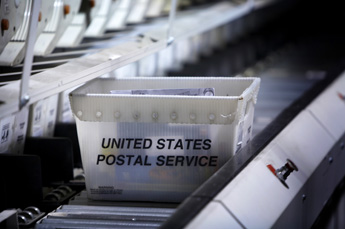The U.S. Postal System lost $1.9 billion in the second quarter of its fiscal year, which ended on March 31. There is little worth comparing between the Post Office’s desperation and the U.S. budget now. That could change in a few years, if federal deficits continue to rise, driven by slow growth and the cost of Social Security and Medicare.
The USPS has an odd relationship to the federal government. Independent in a way that government agencies are not, it is overseen by the Board of Governors of the United States Postal Service. Nine of its 11 governors are appointed by the president. However, its independence has not shielded it from a flat spin that has rendered it financially ruined. Worse, Congress, by an act it passed in 2006, mandates that the Post Office has to fund its pension. And Congress continues to have the power to approve postal rates, though it has not done so in a way that might allow the Post Office to work itself out of its present catastrophic position.
On the federal budget front, Congress and the White House continue to dodge new legislation to bring down federal deficits and the cost to fund the national retirement system. Although there may be a series of compromises that temporarily allow the government to operate, the battles over the deficit cap, taxes and federal spending could go on for years. CBO estimates of the federal deficit and debt:
The deficits that will accumulate under current law will push federal debt held by the public to significantly higher levels. Just two years ago, debt held by the public was less than $6 trillion, or about 40 percent of GDP; at the end of fiscal year 2010, such debt was roughly $9 trillion, or 62 percent of GDP, and by the end of 2021, it is projected to climb to $18 trillion, or 77 percent of GDP. With such a large increase in debt, plus an expected increase in interest rates as the economic recovery strengthens, interest payments on the debt are poised to skyrocket over the next decade. CBO projects that the government’s annual spending on net interest will more than double between 2011 and 2021 as a share of GDP, increasing from 1.5 percent to 3.3 percent.
Before these problems reach the proportions that they may well by 2021, the federal government will face a problem similar to the one the Post Office does now. The pool set up for retired Americans may pass the level where it can be sustained by government funding as it is today.
The Post Office’s recommendations to save itself are not unlike those already debated in Congress as worries about long-term federal deficits grow — cut costs and raise what people have to pay into the system. It is an unpopular remedy as far as most voters are concerned. That does not mean the issue can be avoided.
As it released the financial report with its most recent quarterly figures, Postal Service management said of the need for comprehensive legislation:
The Postal Service needs to save $20 billion annually by 2016. Many of the savings cannot be achieved without the following legislative action:
- Require a USPS Health Care Plan (resolves the Retiree Health Plan prepayment issue)
- Refund the FERS overpayment and adjust the FERS payment schedule
- Adjust delivery frequency (six-day package/five-day mail delivery)
- Streamline the governance model
- Allow USPS the authority to expand products and services
- Require a defined contribution retirement plan for future postal employees
- Provide instructions to arbitrators to consider USPS’s financial condition in interest arbitration awards
- Reform workers’ compensation
And, without question, the cost to mail letters and parcels will have to rise.
Some members of Congress have proposed that America’s retirement plans as funded by the federal government include defined contribution programs, or ones that operate in a similar manner. And adjustments of the extent to which the federal government can offer and services to Americans also will have to shrink, according to most economists, and, indirectly, the Congressional Budget Office.
The Post System’s problems do not mirror those of the federal government today. Over the next decade, that could change.
Cash Back Credit Cards Have Never Been This Good
Credit card companies are at war, handing out free rewards and benefits to win the best customers. A good cash back card can be worth thousands of dollars a year in free money, not to mention other perks like travel, insurance, and access to fancy lounges. See our top picks for the best credit cards today. You won’t want to miss some of these offers.
Flywheel Publishing has partnered with CardRatings for our coverage of credit card products. Flywheel Publishing and CardRatings may receive a commission from card issuers.
Thank you for reading! Have some feedback for us?
Contact the 24/7 Wall St. editorial team.